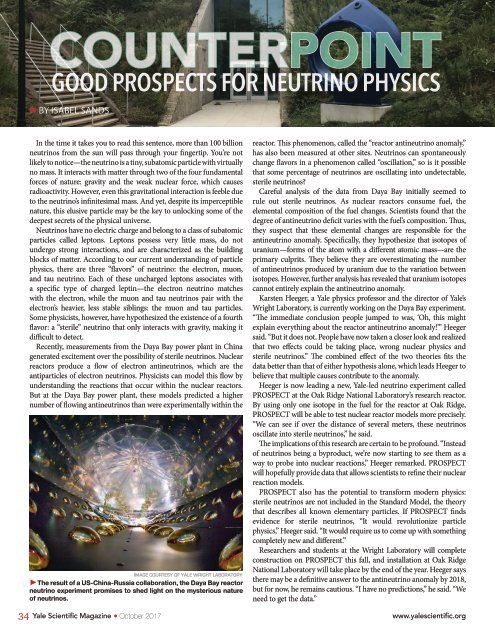YSM Issue 90.4
You also want an ePaper? Increase the reach of your titles
YUMPU automatically turns print PDFs into web optimized ePapers that Google loves.
COUNTERPOINT<br />
GOOD PROSPECTS FOR NEUTRINO PHYSICS<br />
►BY ISABEL SANDS<br />
In the time it takes you to read this sentence, more than 100 billion<br />
neutrinos from the sun will pass through your fingertip. You’re not<br />
likely to notice—the neutrino is a tiny, subatomic particle with virtually<br />
no mass. It interacts with matter through two of the four fundamental<br />
forces of nature: gravity and the weak nuclear force, which causes<br />
radioactivity. However, even this gravitational interaction is feeble due<br />
to the neutrino’s infinitesimal mass. And yet, despite its imperceptible<br />
nature, this elusive particle may be the key to unlocking some of the<br />
deepest secrets of the physical universe.<br />
Neutrinos have no electric charge and belong to a class of subatomic<br />
particles called leptons. Leptons possess very little mass, do not<br />
undergo strong interactions, and are characterized as the building<br />
blocks of matter. According to our current understanding of particle<br />
physics, there are three “flavors” of neutrino: the electron, muon,<br />
and tau neutrino. Each of these uncharged leptons associates with<br />
a specific type of charged leptin—the electron neutrino matches<br />
with the electron, while the muon and tau neutrinos pair with the<br />
electron’s heavier, less stable siblings: the muon and tau particles.<br />
Some physicists, however, have hypothesized the existence of a fourth<br />
flavor: a “sterile” neutrino that only interacts with gravity, making it<br />
difficult to detect.<br />
Recently, measurements from the Daya Bay power plant in China<br />
generated excitement over the possibility of sterile neutrinos. Nuclear<br />
reactors produce a flow of electron antineutrinos, which are the<br />
antiparticles of electron neutrinos. Physicists can model this flow by<br />
understanding the reactions that occur within the nuclear reactors.<br />
But at the Daya Bay power plant, these models predicted a higher<br />
number of flowing antineutrinos than were experimentally within the<br />
IMAGE COURTESY OF YALE WRIGHT LABORATORY<br />
►The result of a US-China-Russia collaboration, the Daya Bay reactor<br />
neutrino experiment promises to shed light on the mysterious nature<br />
of neutrinos.<br />
reactor. This phenomenon, called the “reactor antineutrino anomaly,”<br />
has also been measured at other sites. Neutrinos can spontaneously<br />
change flavors in a phenomenon called “oscillation,” so is it possible<br />
that some percentage of neutrinos are oscillating into undetectable,<br />
sterile neutrinos?<br />
Careful analysis of the data from Daya Bay initially seemed to<br />
rule out sterile neutrinos. As nuclear reactors consume fuel, the<br />
elemental composition of the fuel changes. Scientists found that the<br />
degree of antineutrino deficit varies with the fuel’s composition. Thus,<br />
they suspect that these elemental changes are responsible for the<br />
antineutrino anomaly. Specifically, they hypothesize that isotopes of<br />
uranium—forms of the atom with a different atomic mass—are the<br />
primary culprits. They believe they are overestimating the number<br />
of antineutrinos produced by uranium due to the variation between<br />
isotopes. However, further analysis has revealed that uranium isotopes<br />
cannot entirely explain the antineutrino anomaly.<br />
Karsten Heeger, a Yale physics professor and the director of Yale’s<br />
Wright Laboratory, is currently working on the Daya Bay experiment.<br />
“The immediate conclusion people jumped to was, ‘Oh, this might<br />
explain everything about the reactor antineutrino anomaly!’” Heeger<br />
said. “But it does not. People have now taken a closer look and realized<br />
that two effects could be taking place, wrong nuclear physics and<br />
sterile neutrinos.” The combined effect of the two theories fits the<br />
data better than that of either hypothesis alone, which leads Heeger to<br />
believe that multiple causes contribute to the anomaly.<br />
Heeger is now leading a new, Yale-led neutrino experiment called<br />
PROSPECT at the Oak Ridge National Laboratory’s research reactor.<br />
By using only one isotope in the fuel for the reactor at Oak Ridge,<br />
PROSPECT will be able to test nuclear reactor models more precisely.<br />
“We can see if over the distance of several meters, these neutrinos<br />
oscillate into sterile neutrinos,” he said.<br />
The implications of this research are certain to be profound. “Instead<br />
of neutrinos being a byproduct, we’re now starting to see them as a<br />
way to probe into nuclear reactions,” Heeger remarked. PROSPECT<br />
will hopefully provide data that allows scientists to refine their nuclear<br />
reaction models.<br />
PROSPECT also has the potential to transform modern physics:<br />
sterile neutrinos are not included in the Standard Model, the theory<br />
that describes all known elementary particles. If PROSPECT finds<br />
evidence for sterile neutrinos, “It would revolutionize particle<br />
physics,” Heeger said. “It would require us to come up with something<br />
completely new and different.”<br />
Researchers and students at the Wright Laboratory will complete<br />
construction on PROSPECT this fall, and installation at Oak Ridge<br />
National Laboratory will take place by the end of the year. Heeger says<br />
there may be a definitive answer to the antineutrino anomaly by 2018,<br />
but for now, he remains cautious. “I have no predictions,” he said. “We<br />
need to get the data.”<br />
34 Yale Scientific Magazine October 2017 www.yalescientific.org


















